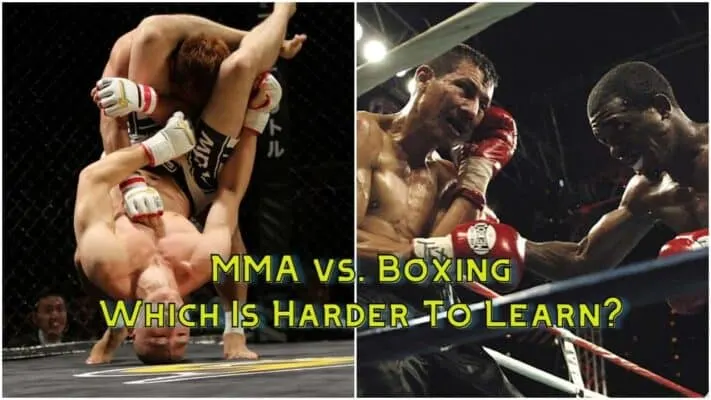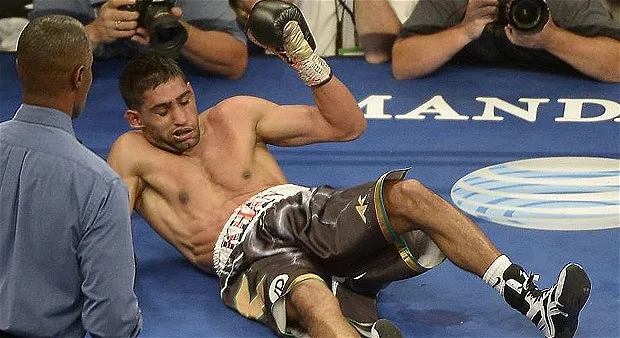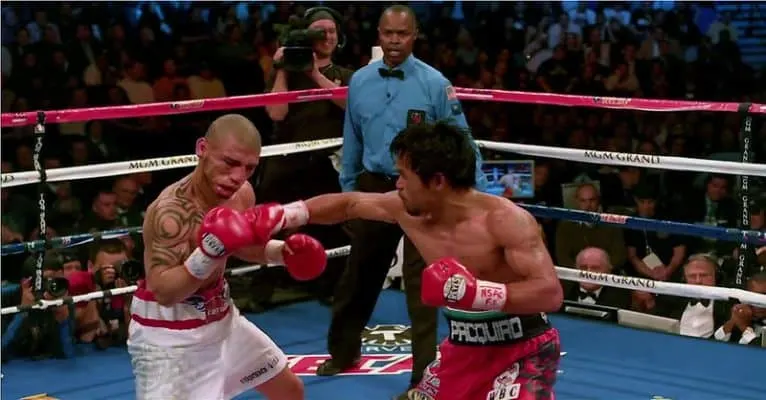
Boxing and Mixed Martial Arts are undoubtedly the two most popular combat sports on the planet, but the debate as to which one is most difficult to learn is never-ending.
On one hand, you have MMA which typically requires at least a base level of proficiency in both striking and grappling arts, on the other hand, you have boxing, a sport where only the most honed, focused and technical pugilists can ascend to the highest echelons.
In this article, MMA vs Boxing, I will further examine which combat sport is harder to learn and which one has an overall higher skill level required to be highly successful as a competitive athlete.
MMA vs Boxing – Which One Is Harder To Learn?
It goes without saying that to be proficient at any sport, particularly a martial art requires a great deal of dedication and perspiration. The hard work involved with both boxing and MMA has a fantastic pay-off for the practitioner in terms of enhanced discipline, improved fitness, weight loss, muscle tone and stress relief but in the initial stages, learning the fundamentals of boxing is arguably much easier than MMA.
The Duke of Queensbury rules limits the attacker to variations of straight punches, hooks, uppercuts and overhands, but all of these strikes, along with kicks, grappling and submission techniques can be found in Mixed Martial Arts. Trying to develop even a basic understanding of all of these skills can be incredibly confusing, so much so that many MMA fighters choose to learn each individual art separately. Finding out how to combine the arts can be even more difficult in MMA – flat-footed wrestling or Jiu Jitsu stances don’t typically lend themselves well to throwing kicks, whilst a side-ways boxing stance is open to both takedowns and leg kicks.
As time goes on, high-level MMA fighters tend to focus on one particular skill set and use their other skills either to protect against the attacks of their opponent or to provide unexpected threats. For example, wrestling specialists are known for faking takedowns and following up with overhand crosses, whilst strikers are sometimes known for “sprawling and brawling” styles – using wrestling to prevent them from being taken down in order to keep the fight on their feet.
Whilst it is not unheard of, it is rare for submission specialists to also be absolute knock-out artists. That being said, if both fighters are more or less equally good grapplers, then striking abilities will come to shine. Conversely, striking art-focused competitors seldomly have as advanced ground-fighting techniques as more grappling-focused ones. Though, if a fighter finds his or her opponent to be a more dangerous striker, they can employ wrestling to slow them down or take them to the ground to follow up with ground and pound, or look for chokes and joint locks.
This can act as a double-edged sword. With more ways to lose, fighters can achieve wins out of seemingly nowhere and champions are rarely dominant for long stretches of time as other fighters exploit weaknesses in their games.
So on paper, with fighters having to develop such well-rounded games it would appear that MMA fighters have a significantly larger amount of skills to learn than boxers. An argument could be made, however, that due to its limitations, boxing with its footwork, feints, slips, dips, rolls and head movement forces the best boxers to have a much higher level of refinement than their 4 oz glove-wearing counterparts.
RECOMMENDED FOR YOU: Why Is Boxing Called The Sweet Science? – Ultimate Answers
What Takes More Skill, Boxing or MMA?
It is almost impossible to have an answer to whether MMA or boxing requires more skill, but to be a high-level boxer, you certainly need a more singular focus. An adage about boxing states that good boxers make their opponent miss by a mile, but great boxers make their opponents miss by an inch. The reason being is that a near miss can allow a fighter to counterpunch. Whilst this evasiveness, punching precision and distance management is important in MMA, it matters for different reasons and an MMA fighter can, in some instances be a fundamentally poor striker if their grappling ability is such a higher standard to compensate for this.
There are also certain angles which MMA fighters will tend not to throw punches from, due to the risk of being kicked or grabbed by their opponent. They also simply don’t have the time to devote to certain punches due to requiring such a broad skillset.
Arguably, the difference between boxing and MMA arguably comes down to subtlety, something is incredibly difficult to quantify. It goes without saying however, that few pugilism purists have transitioned over to MMA with a great deal of success and MMA fighters don’t often make for great boxers.
Is It Easier To Be A Pro Boxer or An MMA fighter?
In terms of whether it is easier to become a professional boxer, or a professional MMA fighter, it is almost undoubtedly the case that it is easier to become a professional MMA fighter. There are a number of reasons for this.
Firstly, MMA is growing so rapidly, that depending on where you are, there may be far more MMA gyms than there are boxing gyms in your area. Many of them operate much more as businesses, rather than the grass-roots community center feel, which boxing gyms have. This means they are often quick to get new students in the door, to not only pay their membership dues, but find willing fighters they can enter into the MMA events of local organizations.
Secondly, boxing has a significantly larger amateur boxing scene. Many boxers spend many years accumulating almost countless wins at amateur level before they turn professional. It is not unheard of for some boxers to go as far as to compete in the Olympics before they start their professional career. MMA doesn’t have this barrier at all, with many fighters skipping amateur fights and heading straight into professional competition.
Perhaps because of this increased level of difficulty in getting to a professional level, the level of potential earnings is almost ubiquitously higher in boxing than MMA. Only the likes of Conor McGregor have earnings in the realms of the big names in boxing and in his case, these earnings stem more from marketing contracts, or the success of his other business ventures.
RECOMMENDED FOR YOU: MMA vs Boxing – Which is More Popular? Simple Analysis
What Requires Higher Amount of Stamina, Boxing or MMA?
Another difficult thing to compare is the levels of stamina needed for both boxing and MMA. Each sport has their heavy hitters – heavily built fighters who are “all or nothing” – trained, or born to throw shots with incredible power, power which comes at a cost – gas tank. Outside of these heavy-hitters, fighters have to prepare for the long haul.
Professional boxing bouts consist of twelve three-minute rounds, so going the distance will involve 36 minutes of actual fighting. MMA on the other hand will consist of three five-minute rounds, or in the case of title fights, five five-minute fights (25 minutes total). This means that boxers have on average more resting time in their fights and shorter rounds before they get to their next opportunity to rest. The difference is going to be related to activity.
Whilst grappling is usually incredibly draining and often becomes a much more anaerobic activity than the breath-aided striking, it can also be used as a stall tactic, for some fighters to recover their energy levels.
One of the complaints spectators of the octagon-based fighting sport is that there is too much “hugging” – either standing clinch work, or grapplers who utilize “lay and pray” tactics to eek out decision victories from taking their opponent down and smothering them to accumulate points. Referees take a significantly longer period-of-time to break fighters up if they do not display enough activity from clinch positions in MMA than they do in boxing matches.
Whilst it is arguable that both arts require roughly the same levels of stamina, Vice president for the UFC Performance Institute, Duncan French analyzed both MMA and boxing to see which one expends more energy during the fight based on the tempo of a fight.
“Importantly, the biggest difference between boxing and MMA is the effort-to-pause ratio, which essentially defines the tempo of a fight,” says French. In boxing, the effort-to-pause ratio averages 3-1, but in professional MMA that ratio is flipped to 1-4, primarily due to the impact of grappling and ground fighting.
Source: The Irish Times
In other words, boxers tend to spend more time working and less time regrouping, requiring boxers to have higher stamina for the fight than MMA fighters do.
Which Is More Dangerous: MMA or Boxing?

Health experts have been able to conduct comparable studies on the risks of injury in MMA and Boxing. The study shows that both boxing and MMA have their inherent dangers, but statistics suggest that boxing is more dangerous than MMA.
A ten-year study undertaken by researchers at the University of Alberta’s Sather Sports Medicine Clinic from 2003 to 2013 was one of the most important studies revealing that boxing leads to more serious injuries than MMA.
These researchers discovered that the injuries which boxers sustain are more likely to affect their health in the long term. MMA fighters may have an increased chance of minor problems such as facial cuts and contusions but overall less major ones.
Of the 1,181 MMA fighters in the study, 59.4% of them received some form of injury in their fights, whereas 49.8% of the 550 boxers received an injury during their, however these injuries were typically much more severe.
7.1% of the 550 boxers evaluated were knocked out or lost consciousness. In comparison, only 4.2% of MMA combatants were knocked out or lost consciousness. This higher rate of concussions precipitated a higher rate of medical suspensions.
This concussion rate is almost certainly from the greater number of significant strikes to the head being thrown in boxing. Boxers can receive hundreds of blows to the head in a single fight, whilst MMA fighters, with their leg and body kicks, and grappling techniques have a wider range of alternatives to winning via KO. These techniques also typically increase the distance MMA fighters engage with each other at. The further they are from each other, the more difficult it is for boxers to land multiple punch combos. These combos are more easily disrupted with kicks, or takedowns.
Submissions can result in torn ACLS, damaged ligaments, dislocated shoulders or even unconsciousness, but even chokes, which can be extremely dangerous if they aren’t released early enough rarely lead to sustained trauma to the brain. In the case of head kicks, they can undoubtedly land with more force than a punch, it is rarely a case that single strikes do the damage, but rather the sheer volume sustained. The greater the volume, the greater the risk.
Lastly, it should be noted that the safety regulations of both sports affect the injury rate. This comes into play in a number of ways. Firstly, although the larger gloves used in boxing would seem like they would protect fighters, they tend to protect their hands more, meaning that they are more willing to throw dangerous shots into their opponents head. 4 oz gloves do not provide the same protection to the brittle bones in a hand and fighters are forced to pick their shots with more precaution.
Secondly, as a latecomer with a grizzly reputation, MMA was forced to develop a ruleset which looks after its competitors more. If an MMA fighter gets hurt and can’t defend themselves, the fight is almost instantly stopped by the referee. Boxing on the other hand allows pugilists to be knocked down and given a ten-second count to get back to their feet and show their ability to continue fighting. Most matches have a three-knockdown, which means a fighter can receive three knockdowns before the fight is over. This can sometimes mean a pugilist will fight for several rounds with a concussion.
RECOMMENDED FOR YOU: Do MMA Fighters Get Brain Damage?
MMA Fighters vs. Boxers: Who Punches Harder?

Whilst both professional MMA fighters and boxers are incredible athletes boxers will typically have a higher force output capacity in their punches. This is usually for two main reasons – the obvious reason is that boxers spend far more of their time focusing on doing one thing: punching. The extended time focused on punching will lead to improved muscle memory and technique.
The less obvious reason is that people who are more naturally built for boxing are likely to gravitate towards the fist-focused sport.
With regard to the actual damage done, boxers with their refined sense of timing and knowledge of angles will be able to achieve a lot more with their punches than MMA fighters do with theirs. Knowing when the exact moment an opponent is committing momentum to their own attack can mean that a boxer can land a clean shot on a vulnerable target like the chin, jaw or temple, further maximizing the impact.
RECOMMENDED FOR YOU: How Hard Can an Average Person Punch?
Should I Choose MMA or Boxing?
Whether you should take up MMA or boxing depends largely on the reasons you wish to train. Both will provide fantastic improvements to your lifestyle in terms of increased fitness, confidence and discipline, but it is arguable that MMA is more useful for self-defense due to the high amount of street fights which either go to the ground, or end up in some form of grappling position. MMA prepares you for any kind of fighting scenario.
If you follow both sports and want to compete professionally, then try to listen to what your heart (for lack of a better word) is calling you to pursue. If you have time, try some classes in each sport, after all there are almost no MMA fighters who don’t train in boxing at some part of their careers. Knowing how to punch properly can only be a benefit.
RECOMMENDED FOR YOU: Which Martial Art Has The Most Injuries? FAQs
